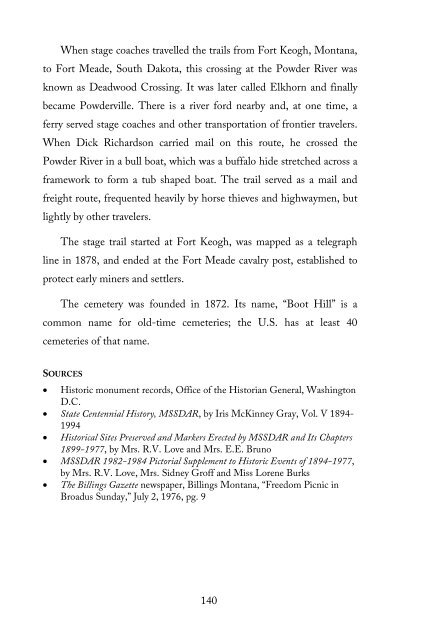Montana's DAR Markers . . . Honoring Where History Was Made
This book is a 200-page thank you to the women of Montana State Society Daughters of the American Revolution for their work in placing historical markers across the state of Montana. Starting in 1908, Montana DAR has installed 70 historical markers across the state. Of those, 33 remain. This book records why the markers’ sites were selected, their history, and the backstory of each.
This book is a 200-page thank you to the women of Montana State Society Daughters of the American Revolution for their work in placing historical markers across the state of Montana. Starting in 1908, Montana DAR has installed 70 historical markers across the state. Of those, 33 remain. This book records why the markers’ sites were selected, their history, and the backstory of each.
Create successful ePaper yourself
Turn your PDF publications into a flip-book with our unique Google optimized e-Paper software.
When stage coaches travelled the trails from Fort Keogh, Montana,<br />
to Fort Meade, South Dakota, this crossing at the Powder River was<br />
known as Deadwood Crossing. It was later called Elkhorn and finally<br />
became Powderville. There is a river ford nearby and, at one time, a<br />
ferry served stage coaches and other transportation of frontier travelers.<br />
When Dick Richardson carried mail on this route, he crossed the<br />
Powder River in a bull boat, which was a buffalo hide stretched across a<br />
framework to form a tub shaped boat. The trail served as a mail and<br />
freight route, frequented heavily by horse thieves and highwaymen, but<br />
lightly by other travelers.<br />
The stage trail started at Fort Keogh, was mapped as a telegraph<br />
line in 1878, and ended at the Fort Meade cavalry post, established to<br />
protect early miners and settlers.<br />
The cemetery was founded in 1872. Its name, “Boot Hill” is a<br />
common name for old-time cemeteries; the U.S. has at least 40<br />
cemeteries of that name.<br />
SOURCES<br />
• Historic monument records, Office of the Historian General, <strong>Was</strong>hington<br />
D.C.<br />
• State Centennial <strong>History</strong>, MSS<strong>DAR</strong>, by Iris McKinney Gray, Vol. V 1894-<br />
1994<br />
• Historical Sites Preserved and <strong>Markers</strong> Erected by MSS<strong>DAR</strong> and Its Chapters<br />
1899-1977, by Mrs. R.V. Love and Mrs. E.E. Bruno<br />
• MSS<strong>DAR</strong> 1982-1984 Pictorial Supplement to Historic Events of 1894-1977,<br />
by Mrs. R.V. Love, Mrs. Sidney Groff and Miss Lorene Burks<br />
• The Billings Gazette newspaper, Billings Montana, “Freedom Picnic in<br />
Broadus Sunday,” July 2, 1976, pg. 9<br />
140





